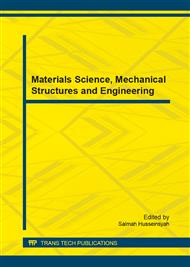p.271
p.276
p.280
p.284
p.288
p.292
p.299
p.303
p.307
Development of Droplets Penetrating Roots Performance Test Device and Tests Applied this Device in Ultrasonic Aeroponic System
Abstract:
Extremely flourishing roots of aeroponic plant lead droplets difficult to penetrate into the core of roots. This phenomenon is so-called “external is wet but internal is dry” and seriously affects areoponic efficiency, even result in aeroponic culture failure. In order to research droplets penetrating roots performance in ultrasonic aeroponic system, an intelligent test device was developed. This device included two ultrasonic nozzles whose working frequencies were 1.7MHz and 40kHz respectively, nozzles’ drive circuit, acquisition system of humidity and temperature based on ARM 9.0 and axial flow fan. The following conclusions were suggested: under the mature cherry tomatoes root system density cultured in aeroponic system, droplets generated by 1.7MHz ultrasonic atomizing nozzle were easier to penetrate into the core of the root; both size and concentration of droplets influenced droplets penetrating into the root; when 1.7MHz nozzle was used to atomization, the best penetrating condition was found in supply air rate 0.021and spray volume 0.4L/h; for 40kHz atomizing nozzle , the best penetrating condition was found in supply air rate 0.021and spray volume 1.2L/h; for 1.7MHz nozzle the worst work conditions of penetrating into the root were that supply air rate was 0.014and spray volume was 0.8L/h and for 40kHz nozzle that was supply air rate 0.033and spray volume 1.2L/h.
Info:
Periodical:
Pages:
288-291
Citation:
Online since:
October 2014
Authors:
Price:
Сopyright:
© 2014 Trans Tech Publications Ltd. All Rights Reserved
Share:
Citation:


